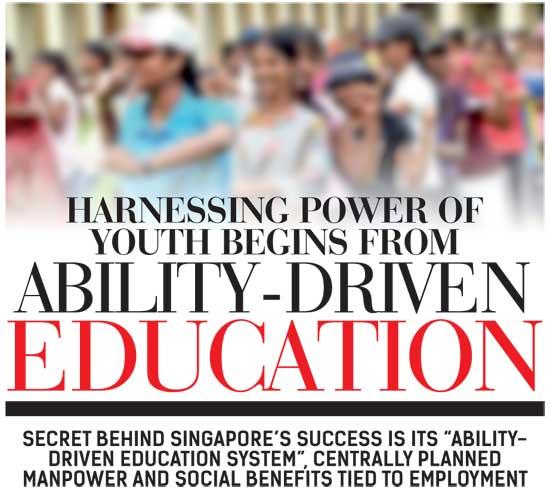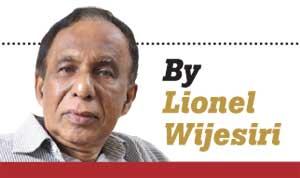09 Dec 2019 - {{hitsCtrl.values.hits}}
In his election manifesto presented to the public, President Gotabaya Rajapaksa said, “The country’s youth, who account for almost one fourth of the total population, will be engaged as  proactive partners in the country’s sustainable development process. We will identify their aspirations and develop an effective programme to enable young people to reach their full potential.”
proactive partners in the country’s sustainable development process. We will identify their aspirations and develop an effective programme to enable young people to reach their full potential.”
It is quite possible that he sincerely wants to harness the full power of youth and if so, I believe he should first take a hard look at our obsolete education system. Skills and educational development for inclusive and sustainable growth are becoming significant drivers in most developing countries. Sadly, Sri Lanka is lagging behind on this important challenge. We are not effectively working towards developing integrated pathways of skills and employment.
Look at this scenario. Nearly 300,000 young people sit the GCE A/L Examination, of which less than 10% enter our local universities. For example, last year, only 26,000 youth qualified themselves to enter state universities. The sad fact is 48% of them were absorbed to Arts faculties. Inevitably, they will come out of campuses practically “unskilled” and demand “government jobs” or remain unemployed. The more professionally orientated faculties such as medicine, engineering, law, architecture, management and accounting etc., guide their students through a defined path reaching high potential of employability.
This major issue creates two other important supplementary concerns. First, what about the youths who were entitled but, due to no fault of theirs, couldn’t enter any state university. What can they do to further their education if they cannot afford to pay the high fees of private universities? The second concern is about the large group of youth who are only GCE O/L qualified. What is their future? These are serious issues. Unfortunately, successive Governments seemed to have not understood this problem in right perspective and, therefore, have failed to find a remedy.
Government statistics show as at end of 2017, our overall youth (age 15-24) unemployment rate is 18.5% for both male and female. The majority among unemployed are the new entrants to job market or new job seekers, who are in age group 20-24 years. The highest unemployment rate is reported from educated group GCE (A/L) and above which is reported as 8.1%. What is the main reason for this dismal situation? I believe the answer boils down to our rigid and out-dated education system.
Maybe, we can learn a lesson or two from Singapore. Singapore is well-known in international circles for its success in developing a high performing education system as well as for its  dynamic, future-oriented and industry-linked skill development initiatives. With a strong reform culture and well-funded Pre-employment Education and Training (PET) and Continuing Education and Training (CET), Singapore has succeeded well in addressing skills demand in its every phase of development.
dynamic, future-oriented and industry-linked skill development initiatives. With a strong reform culture and well-funded Pre-employment Education and Training (PET) and Continuing Education and Training (CET), Singapore has succeeded well in addressing skills demand in its every phase of development.
The secret behind Singapore’s success is its “ability-driven education system”, centrally planned manpower and social benefits tied to employment. In a presentation, National Institute of Education (Singapore) examines the concept of ability-driven education and discusses a number of problems and opportunities associated with its implementation.
What is meant by ability-driven education System? It is based on the belief that every child has some special talent or ability. The scope and scale of talent within each student may differ, but the Singapore government believes that all students should be given the opportunity to excel according to the combination of talents and abilities they possess.
To excel does not necessarily mean to be the best in a narrowly defined area common to all; it means being the best one can be in one’s own talent spheres. Within one school organization, there can be many different identified talent spheres each with its own “one of the best-in-class” individuals.
This recognition of individual talents and abilities is similar to the theory of multiple intelligence written in 1983 by Howard Gardener(Research Professor of Cognition and Education at Harvard University). He categorized eight relatively independent dimensions of youth intelligence which include: (a) linguistic intelligence (poet, journalist); (b) logical-mathematical intelligence (scientist, mathematician); (c) musical intelligence (composer, violinist); (d) spatial intelligence (sculptor, navigator); (e) bodily-kinaesthetic intelligence (dancer, athlete); (f) interpersonal intelligence (therapist, salesperson); (g) intra-personal intelligence (business leader, self-aware individual)
The concept of multiple intelligence has a distinct appeal. For example, a youth may not be high in linguistic dimensions, but excel in perhaps spatial ability. The emphasis in an ability-driven education system is to recognize and develop these different categories of student intelligence.
Ability-driven education has a number of other undertones as well. While harnessing the diverse talents and abilities of students, the education system also inculcates in them the appropriate national and social values so that they may actively participate in National development. The teachers are fully committed to deliver the best educational opportunities to students. All three factors, harnessing individual talents, developing social values and acquiring best education are embodied in the Singapore education system.
With the introduction of this change, there were fundamental changes to the education system in Singapore. One on hand, students were offered a more varied selection in terms of the curriculum, teaching and learning strategies, and modes of assessment. But on the other hand, Singapore experienced a number of problems associated with its implementation but with time, they managed to overcome all of them.
An initial problem faced by the teachers and administrators was to find a balance between the provision of a core curriculum, necessary for the development of attitudes, skills and knowledge, and a more ability driven curriculum to harness the energy and resourcefulness of teachers and the enthusiasm and creativity of pupils. The originators of the scheme believed that when the interests and needs of the students are incorporated into the curriculum, they are intrinsically motivated to participate in the learning process.
At one level, the ability-driven curriculum consists of numerous course electives, extension courses, mini-courses and alternative courses offered by a particular school. At another level, there is the promotion of “niche” programmes through the cluster school system. It means that for certain schools in one area can offer “niche” programmes in science, art, music, drama, sport, or languages. These schools could attract pupils from other schools in the cluster and possibly recruit a group of specialist staff to deliver the programmes.
The development of an ability-driven curriculum offered more academic freedom for the staff. For example, teachers and students can discuss and choose subject and instructional materials relevant to a particular course.
In essence, the “ability-driven education” would, according to the National Institute of Education, Singapore, “ give all youth ten years of general education, including six years of compulsory education at the primary level, during which they could participate in a variety of programs according to their ability. The school system features a national curriculum, with major national examinations at the end of the primary, secondary, and junior college years. Proponents of the Singaporean education prototype have advocated that its advantages include learning tailored to the child’s abilities and needs due to the separation of the academically inclined from the vocationally inclined. Accordingly, young people are trained with different sets of skills and channelled into different segments of the workforce.
Coupled with a history of central manpower planning in Singapore that hinges on the close collaboration between the ministries of education, manpower and trade, these changes have allowed for the government to ensure that workforce demands were met with optimum levels of workers supply. From, 2012 to present, Singapore has introduced a “Student-centric, values-driven phase.” This framework articulates the core competencies and values that will enable the youth of Singapore to get employed anywhere in the world in the 21st century.
Can we introduce ability-driven education in Sri Lanka? I personally believe, we can. The government must first embark on a drastic reform of our education policy giving high concentration to youth training, intensifying its efforts to increase the number of skilled workers. To do so, it needs to formulate a new National Skills Development Policy and setup a new institutional framework to accelerate and coordinate skills-development efforts and create an ability-driven (or Student-centric, value-driven) education system in Sri Lanka.
Despite the changing competitive environment, many of our educators seem to lack the competitive and efficiency-oriented thinking which guide business in the private sector, and hence, they continue to manage schools in the same way it was done 75 years ago. There is no provision in the system to meet the aspirations of the youths and assisting them in maximizing their potential.
All stakeholders in the education system need to accept the fact that they can no longer continue with this outdated system. Through mutual understanding, open-hearted interaction and constant dialogue, all the key stakeholders need to decide on what is really best for the country and its critical resource – its children and youth. The experience of Singapore will give them some food for thought.
19 Apr 2024 36 minute ago
19 Apr 2024 2 hours ago
19 Apr 2024 2 hours ago
19 Apr 2024 2 hours ago
19 Apr 2024 2 hours ago